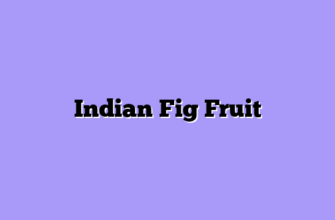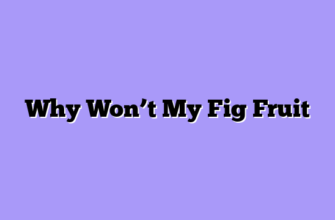There’s something magical about the Ficus carica, better known as the common fig. But when it comes to the Lebanese fig, that magic takes on a deeper meaning — one rooted in the Mediterranean sun, limestone hills, and centuries of careful cultivation. Locally, it’s called Teen Lubnani (تِين لُبْنَانِي), and to many in Lebanon, it’s more than just a fruit — it’s a cultural emblem. You’ll find it growing on terraces in Mount Lebanon, in backyard gardens along the coast, and even in old groves that seem to cling to the cliffsides.
As someone who’s spent years growing exotic fruits from around the world — from dragon fruit to mangosteen — the Lebanese fig holds a special place in my orchard. It’s a plant that carries a story, a flavor, and a spirit of survival that few fruits can match.
What Makes the Lebanese Fig Unique?
You might be surprised to know that Lebanon is home to several distinct varieties of figs. The most famous is the Bekaa Valley Fig, often a deep purplish-black on the outside with a bright ruby-red interior that bleeds sweet nectar when ripe. Other types, like the Bayrouti or Aswad, have their own quirks — some are sweeter, some more robust, others dry better for winter storage.

When I first planted Lebanese figs in my orchard, I noticed immediately how different they were from, say, California’s Mission fig or Turkey’s Sarilop. The Lebanese types tend to produce smaller, tighter fruits, with skin that’s more delicate and flesh that’s almost jam-like. They ripen fast, too — one day they’re firm, the next they’re bursting with honey.
Table 1: Comparing Lebanese Fig Varieties
| Variety (Local Name) | Skin Color | Flesh Color | Flavor Notes | Common Use |
|---|---|---|---|---|
| Bayrouti (بيروتي) | Greenish-yellow | Pink-red | Mildly sweet, floral | Fresh eating |
| Aswad (أسود) | Deep purple | Red | Rich, syrupy, caramel undertone | Fresh or dried |
| Bekaa (بقاعي) | Brown-purple | Ruby red | Sweet with slight tang | Fresh, preserves |
| White Lubnani | Pale yellow | Amber | Light, honeyed | Drying, jams |
What makes the Lebanese fig stand out isn’t just the flavor — it’s the texture. It’s denser, silkier, less watery than other Mediterranean figs. I’ve had chefs describe it as “the crème brûlée of figs” — and I have to agree.
Growing Lebanese Figs: Lessons from the Orchard
When you grow Lebanese figs outside their native soil, you quickly learn how picky they can be. These trees love sun, limestone-rich soil, and steady moisture — but not too much. In Lebanon, many fig trees grow on terraced hills where rainwater drains freely, keeping the roots dry even in wet seasons.
In my own farm, I replicated that environment by mixing crushed limestone and sand into the soil. It was a simple trick, but it changed everything. The figs started producing richer, more aromatic fruits — a clear sign they were finally “at home.”
One thing I always tell new fig growers: never overwater a Lebanese fig. The roots hate sitting in water. They’ll punish you with dropped fruit and sour taste. Instead, give them deep, infrequent watering — enough to mimic the natural rhythm of Mediterranean rainfall.
Temperature also plays a big role. The sweet spot for Lebanese figs is between 75°F and 90°F during the day, with cooler nights that help lock in sugars. I’ve tested this by planting trees on different slopes — the ones that got afternoon shade produced sweeter fruit than those exposed to full sun all day.
The Cultural Side of the Lebanese Fig
For many Lebanese families, the fig tree isn’t just a plant — it’s part of the household. I once visited a family near Zahle who had an enormous teen tree shading their entire courtyard. The grandmother told me it was planted by her father before the civil war. Every summer, the family gathers to make fig jam — or mouneh — cooking the fruit slowly with a bit of lemon juice until it turns thick and glossy.
Figs also hold symbolic value. In rural villages, planting a fig tree often marks the birth of a child — a living promise that both will grow strong and bear fruit. And it’s not just poetic talk; a mature Lebanese fig tree can yield up to 150–200 pounds of fruit each year under ideal conditions. That’s a lot of sweetness from one set of roots.
Table 2: Traditional and Modern Uses of Lebanese Fig
| Use Type | Description | Common Practice |
|---|---|---|
| Culinary | Fresh fruit, jam, syrup (dibs el teen), pastries | Used in sweets like ma’amoul and fig rolls |
| Medicinal | Natural laxative, digestive aid | Dried figs boiled with anise seeds |
| Agricultural | Shade tree, soil stabilizer | Often planted along terraces |
| Religious | Mentioned in the Bible and Quran | Symbol of peace and prosperity |
Challenges and Solutions in Cultivating Lebanese Figs
Of course, growing Lebanese figs outside Lebanon isn’t always smooth sailing. I’ve lost crops to sudden rainstorms that cracked the fruits just before harvest. Birds love them — starlings, crows, even my neighbor’s chickens have developed a taste for them.
Then there’s the issue of fig drop, especially during dry spells. The Lebanese fig tends to form fruit earlier than other types, making it vulnerable to temperature swings. The fix? Mulching. A thick layer of straw or compost keeps soil temperature stable and roots comfortable.
Pests are another battle. Fig scale insects and nematodes can ruin your yield if you’re not vigilant. I’ve had good luck controlling them with neem oil and by planting marigolds nearby — they act as natural nematode deterrents.
Quick Tip:
• Lebanese figs respond well to organic fertilizers high in potassium — banana peels, wood ash, or composted grape skins work wonders for sweetness and size.
A Personal Experiment: The “Desert Fig” Trial
A few years back, I decided to push the limits and test how well the Lebanese fig could adapt to arid conditions. I planted a small plot in sandy soil with minimal irrigation, similar to what you might find in parts of southern Lebanon or Jordan.
The results were surprising — while the trees grew slower, the fruits were incredible. They developed a thick skin and an even higher sugar content — around 26° Brix, compared to the average 20–22° for most figs. The flavor was like caramelized honey with a touch of salt air. That experiment taught me that stress, when managed right, can actually improve flavor.
How to Enjoy Lebanese Figs
You can’t talk about figs without talking about how to eat them. And trust me — once you taste a ripe Lebanese fig, you’ll understand why people write poetry about them.
Here’s my personal top 5 ways to enjoy Lebanese figs:
-
Fresh and raw, straight from the tree (still warm from the sun).
-
With cheese, especially goat cheese or labneh, drizzled with olive oil.
-
In salads, mixed with arugula, walnuts, and pomegranate molasses.
-
Dried, for a chewy, candy-like snack in winter.
-
As jam or syrup, spread over bread or used in pastries.
I even make a homemade fig liqueur — steeping dried Lebanese figs in brandy with cinnamon and cardamom. It tastes like liquid gold.
Lessons Learned from Growing Lebanese Figs
Over the years, I’ve realized that Lebanese figs are like the people of Lebanon themselves — resilient, adaptable, and deeply rooted in tradition. They thrive in hardship, flourish under sun, and carry generations of history in every bite.
They’ve taught me patience — figs don’t ripen on demand. They’ve taught me balance — too much care can be as harmful as neglect. And most of all, they’ve reminded me that farming isn’t about forcing nature, but working with it.
Final Thoughts
So, why do I keep growing Lebanese figs when there are easier, more profitable fruits out there? Because every fig I pick feels like a small miracle. It connects me to the old farmers in the hills of Batroun, to the families in Beirut making fig jam in copper pots, and to the global thread that ties us all through food and soil.
If you ever get the chance to plant one, do it. Whether you call it Ficus carica, Teen Lubnani, or simply “that sweet tree from the Mediterranean,” it will reward you with more than fruit — it’ll give you stories, memories, and a sense of continuity that’s rare in this fast world.
And when you bite into that first perfectly ripe fig — soft, fragrant, dripping with amber syrup — you’ll understand why, in Lebanon and beyond, the fig is not just a fruit, but a way of life.








